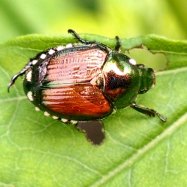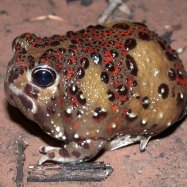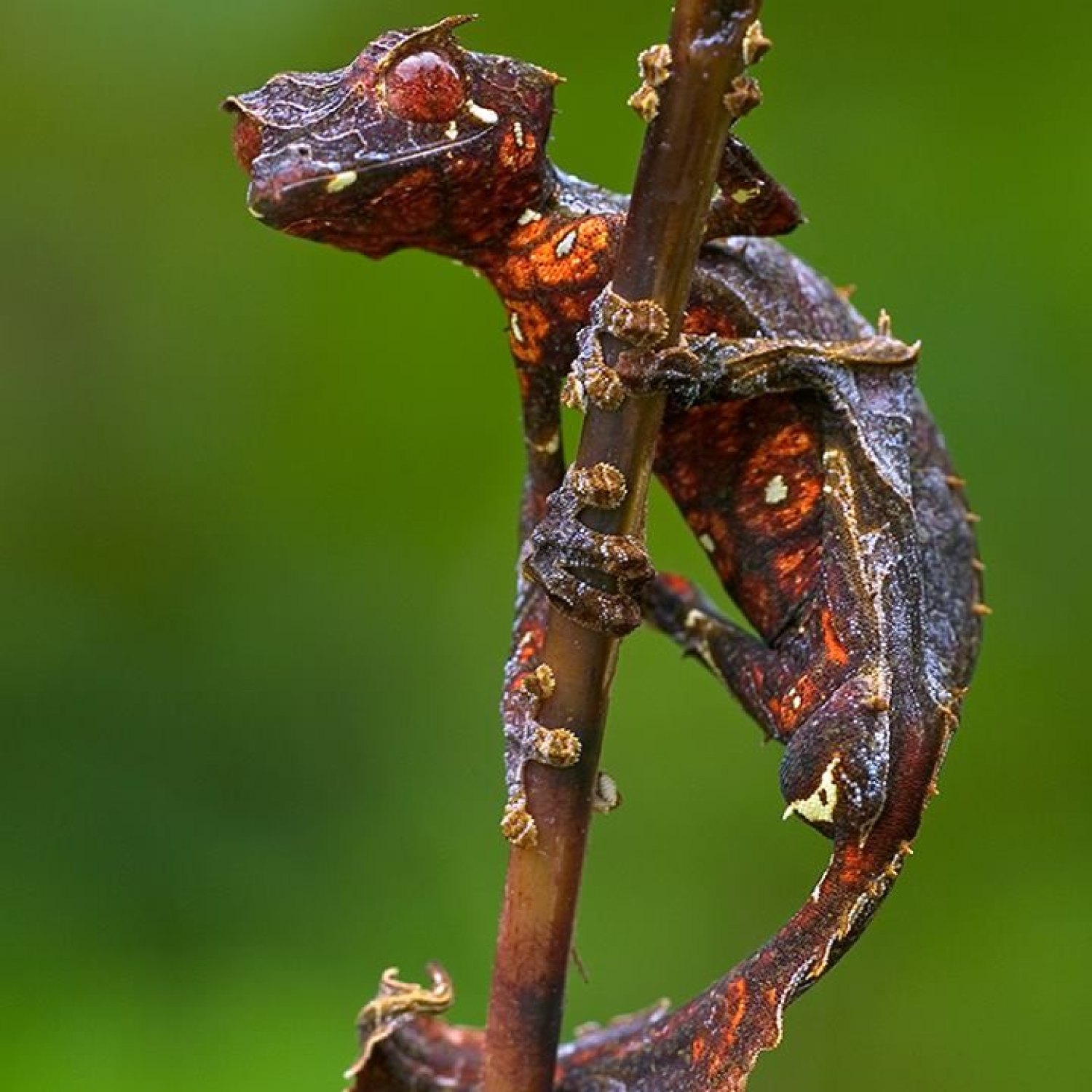
Satanic Leaf Tailed Gecko
7-9 centimeters
The Satanic Leaf Tailed Gecko, found in the rainforests of eastern Madagascar, is a fascinating creature with a unique body shape resembling a leaf. This gecko is part of the Gekkonidae family and can grow up to 7-9 centimeters in length. With its distinct appearance and habitat, it's no wonder why this gecko is a popular choice among reptile enthusiasts.
Animal Details Summary:
Common Name: Satanic Leaf Tailed Gecko
Kingdom: Animalia
Habitat: Rainforests
The Devil in Disguise: Unraveling the Mysteries of the Satanic Leaf Tailed Gecko
Deep in the rainforests of Madagascar, there lurks a creature like no other. With its haunting appearance and elusive nature, the Satanic Leaf Tailed Gecko has fascinated and intrigued both scientists and nature enthusiasts alike. Despite its devilish moniker, this unique reptile is not as evil as it sounds. In fact, its name is derived from its incredible ability to camouflage itself as a leaf, making it one of the most interesting and enigmatic creatures in the animal kingdom Satanic Leaf Tailed Gecko.Origins and Taxonomy
The Satanic Leaf Tailed Gecko, also known by its scientific name Uroplatus phantasticus, belongs to the kingdom Animalia and phylum Chordata. It falls under the class Reptilia and order Squamata, which is a group of reptiles with scale-covered skin. Its family is Gekkonidae, which includes other gecko species found mainly in Madagascar, Africa, and Asia. The Satanic Leaf Tailed Gecko is a type of gecko that is endemic to Madagascar, meaning it can only be found in this exotic island nation off the southeastern coast of Africa.
Appearance
One of the most striking features of the Satanic Leaf Tailed Gecko is its appearance. Measuring only 7-9 centimeters in length, it is relatively small in comparison to other geckos. However, what it lacks in size, it more than makes up for in its unique body shape and coloration.
As its name suggests, this gecko has a body that resembles a leaf. Its brown, green, and black coloration, along with its leaf-like appearance, allows it to blend seamlessly with its surroundings Sardines. This remarkable camouflage, paired with its nocturnal lifestyle, makes it extremely difficult to spot in the wild.
The Satanic Leaf Tailed Gecko also has large, lidless eyes that are specially adapted for low light conditions, allowing it to hunt for prey at night. Its eyes are also incredibly sensitive, enabling it to detect even the slightest movements, which is essential for its survival in the wild.
Habitat and Range
The Satanic Leaf Tailed Gecko is native to the eastern rainforests of Madagascar, where it makes its home in the dense foliage. These rainforests are known for their high biodiversity, and the Satanic Leaf Tailed Gecko is just one of the many unique creatures that call it home. Their natural habitat is humid and warm with plenty of vegetation and insects, which is the primary source of their food.
Diet
As with most gecko species, the Satanic Leaf Tailed Gecko is an insectivore, which means that its diet primarily consists of insects. However, unlike other insects, it is not a fast and agile hunter. Its hunting strategy is unique, as it relies heavily on stealth and camouflage to capture its prey. It sits still, waiting patiently for unsuspecting insects to come within its reach, then strikes with lightning-fast accuracy.
Behavior and Adaptations
The Satanic Leaf Tailed Gecko is a solitary creature and is primarily active at night. During the day, it remains motionless, blending in with its surroundings to avoid being spotted by predators. This gecko is an expert at mimicking inanimate objects, and it even has fringes on its body that resemble veins seen on actual leaves.
Another fascinating adaptation of this gecko is its ability to shed its tail when threatened, a behavior known as "autotomy." This serves as a distraction to predators, giving the gecko a chance to make a quick escape. The tail will then regenerate, but not as a perfect replica of the original. This survival mechanism is essential in its natural habitat, where predators are plentiful.
Conservation Status and Threats
Unfortunately, like many other species in Madagascar, the Satanic Leaf Tailed Gecko is facing threats to its survival. The loss of its natural habitat due to deforestation and human encroachment is a significant threat to this species. Additionally, this gecko is also traded on the black market, making it a target for illegal pet trade. As a result, the IUCN Red List has classified it as "vulnerable," and steps are being taken to protect this unique creature from further decline.
However, conservation efforts are being made, and organizations such as the Rainforest Trust and Madagascar Fauna and Flora Group are working towards protecting the rainforests and the species that call it home. Education and awareness programs are also in place to educate the local community about the importance of preserving these precious habitats.
Fun Facts
- The Satanic Leaf Tailed Gecko was only formally described by scientists in 1888, making it a relatively recent discovery.
- This gecko is often referred to as a "living fossil" due to its close resemblance to its prehistoric ancestors.
- It is known to "plays dead" when threatened, using its tail to cover its head, making it look like a withered leaf.
- The Satanic Leaf Tailed Gecko is also called a "phantasticus," which is derived from its scientific name and means "seen to be different."
- It has been featured in numerous National Geographic documentaries and has gained worldwide attention for its unique appearance.
In conclusion, the Satanic Leaf Tailed Gecko is not as sinister as it sounds. Its eerie name and appearance may instill fear in some, but it is, in fact, a fascinating and well-adapted creature that has found its niche in the dense rainforests of Madagascar. With continued conservation efforts, we can ensure that this unique and incredible species continues to thrive in its natural habitat.

Satanic Leaf Tailed Gecko
Animal Details Satanic Leaf Tailed Gecko - Scientific Name: Uroplatus phantasticus
- Category: Animals S
- Scientific Name: Uroplatus phantasticus
- Common Name: Satanic Leaf Tailed Gecko
- Kingdom: Animalia
- Phylum: Chordata
- Class: Reptilia
- Order: Squamata
- Family: Gekkonidae
- Habitat: Rainforests
- Feeding Method: Insectivore
- Geographical Distribution: Madagascar
- Country of Origin: Madagascar
- Location: Rainforests of eastern Madagascar
- Animal Coloration: Brown, green, and black
- Body Shape: Leaf-like
- Length: 7-9 centimeters
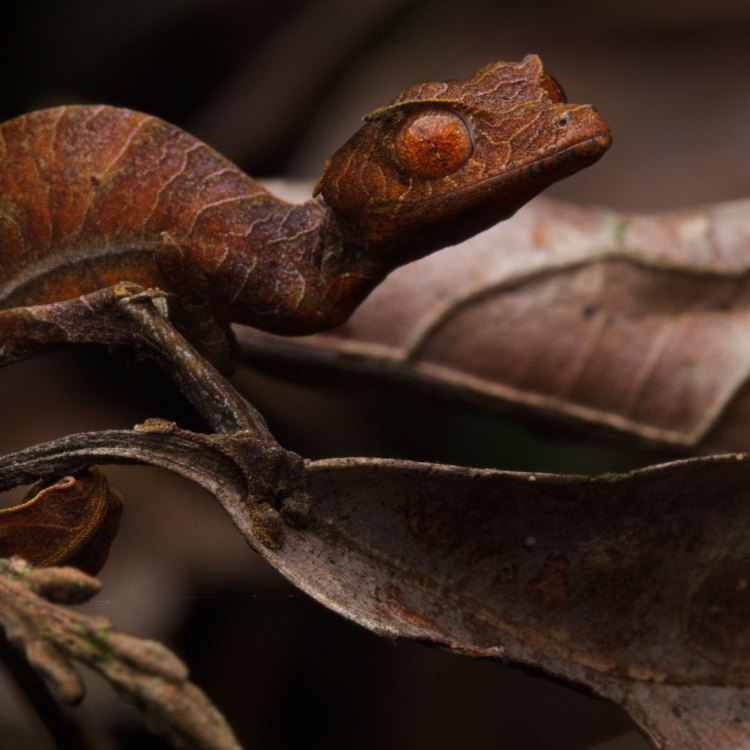
Satanic Leaf Tailed Gecko
- Adult Size: Small
- Average Lifespan: 6-10 years
- Reproduction: Oviparous (laying eggs)
- Reproductive Behavior: Males compete for females
- Sound or Call: Not known to make sounds
- Migration Pattern: Non-migratory
- Social Groups: Solitary
- Behavior: Nocturnal and arboreal
- Threats: Habitat loss, illegal pet trade
- Conservation Status: Vulnerable
- Impact on Ecosystem: Plays a role in ecosystem balance by controlling insect populations
- Human Use: Collected for the pet trade
- Distinctive Features: Leaf-like body shape and coloration
- Interesting Facts: The Satanic Leaf Tailed Gecko gets its name from its leaf-like appearance and the horn-like scales above its eyes.
- Predator: Birds and snakes
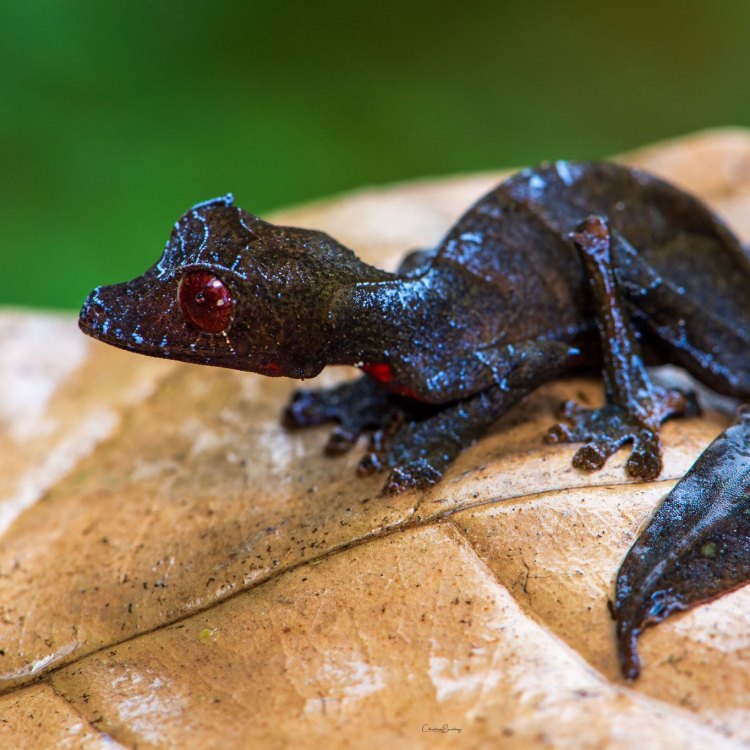
Uroplatus phantasticus
The Fascinating World of the Satanic Leaf Tailed Gecko
In the dark and dense forests of Madagascar, lives a creature that looks like it has emerged from the realms of fantasy. With its unique appearance and elusive nature, the Satanic Leaf Tailed Gecko (Uroplatus phantasticus) has captured the hearts of many reptile enthusiasts. Its name alone is enough to spark curiosity and pique interests. In this article, we will delve into the world of this mysterious creature and learn about its distinct features, behavior, threats, and much more PeaceOfAnimals.Com.Size and Lifespan
The Satanic Leaf Tailed Gecko is a small species of gecko, with adults reaching an average length of 5-6 inches. Their size is not the only fascinating thing about them; they also have a relatively long lifespan for a reptile, living up to 6-10 years in captivity. In the wild, their lifespan may vary depending on their habitat and predators.Reproduction Behavior
Satanic Leaf Tailed Geckos are oviparous, meaning they reproduce by laying eggs. Breeding season for them usually takes place in the summer months, and males compete fiercely for opportunities to mate. Male geckos will often display dominance by showcasing their vibrant colors and engaging in physical combat.Once the female lays her eggs, she will bury them in a secluded spot, and they will take around 60-90 days to hatch. Care should be taken by pet owners, as the eggs are delicate and can easily be damaged.
Behavior and Habitat
The Satanic Leaf Tailed Gecko is known for its nocturnal and arboreal behavior Snake. These creatures are hardly ever seen in the day as they spend most of their time perched on branches and leaves, perfectly blending in with their surroundings. Their leaf-like body shape and coloration allows them to camouflage and hide from predators such as birds and snakes.Being solitary animals, they prefer to live alone, with little to no interaction with other geckos. They are also known for their territorial behavior and may become aggressive towards other geckos if their space is invaded.
These geckos are also excellent climbers thanks to their unique toe pads that allow them to grip onto surfaces with ease. However, they are not fast-moving creatures and usually rely on their camouflage to stay hidden from predators.
Threats and Conservation Status
The Satanic Leaf Tailed Gecko is facing several threats in its natural habitat. One of the main threats is habitat loss due to deforestation and human encroachment. These creatures require a specific type of environment to thrive, and as their habitat continues to shrink, their survival becomes increasingly at risk.Another threat to their population is the illegal pet trade. Due to their unique appearance, Satanic Leaf Tailed Geckos are highly sought after by collectors and can fetch high prices on the black market. This has led to a decline in their numbers, and they are now listed as a vulnerable species by the IUCN Red List.
Role in the Ecosystem
Although these creatures may seem insignificant, they play a vital role in the ecosystem. As insectivores, Satanic Leaf Tailed Geckos help to control insect populations, maintaining a balance in their ecosystem. Without them, there could be potential outbreaks of pests, affecting the local flora and fauna.Their unique leaf-like bodies also help them to blend in with their surroundings, making them less susceptible to predation. This, in turn, helps to maintain a healthy population of these geckos in their natural habitat.
Human Interaction
Unfortunately, due to their distinct appearance, Satanic Leaf Tailed Geckos have become popular in the illegal pet trade. These creatures are not easy to keep in captivity and require specific care and conditions to thrive. Pet owners should be well-informed and prepared before taking on the responsibility of owning one of these creatures.In recent years, conservation efforts have been made to protect and preserve these unique creatures. Organizations such as the Madagascar Fauna and Flora Group have been working towards creating awareness and establishing protected areas for the Satanic Leaf Tailed Gecko and other endangered species in Madagascar.
Interesting Facts
The Satanic Leaf Tailed Gecko gets its name from its distinctive leaf-like appearance and the horn-like scales above its eyes, giving it an eerie resemblance to the devil.This gecko species was first discovered in 1906 by a French herpetologist, but it was not seen again until 1994, where it was rediscovered by researchers in Madagascar.
Believed to be originally from the rainforests of Madagascar, Satanic Leaf Tailed Geckos are now found in various zoos and private collections across the world.
As nocturnal creatures, they have large, sensitive eyes that can see in the dark, thanks to their vertical pupils, which can dilate to let in more light.
Despite their leaf-like appearance, their colors can vary from different shades of green to brown, depending on their habitat and surroundings.
Conclusion
The Satanic Leaf Tailed Gecko is a unique and fascinating creature that continues to intrigue researchers and wildlife enthusiasts alike. Its leaf-like appearance, solitary behavior, and elusive nature make it a prized species to see in the wild.However, with human-caused threats and the illegal pet trade, this beautiful creature's survival is at risk. It is crucial to educate ourselves and others on the importance of conservation efforts to protect and preserve these fantastic creatures. Only then can we ensure their survival for future generations to appreciate and admire the Satanic Leaf Tailed Gecko's unique beauty and role in the ecosystem.
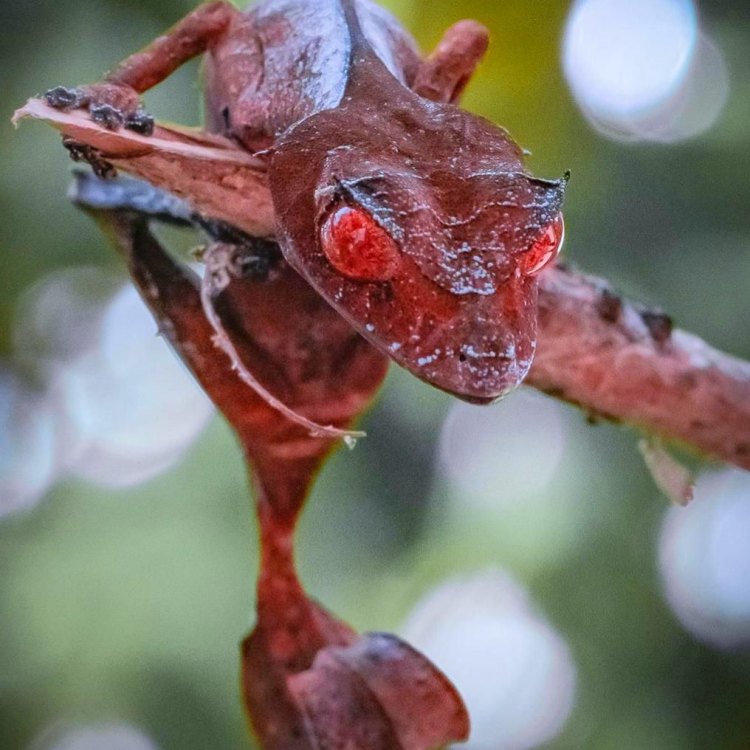
The Devil in Disguise: Unraveling the Mysteries of the Satanic Leaf Tailed Gecko
Disclaimer: The content provided is for informational purposes only. We cannot guarantee the accuracy of the information on this page 100%. All information provided here may change without prior notice.








